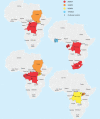Ebola virus vaccines: an overview of current approaches
- PMID: 24575870
- PMCID: PMC4785864
- DOI: 10.1586/14760584.2014.885841
Ebola virus vaccines: an overview of current approaches
Abstract
Ebola hemorrhagic fever is one of the most fatal viral diseases worldwide affecting humans and nonhuman primates. Although infections only occur frequently in Central Africa, the virus has the potential to spread globally and is classified as a category A pathogen that could be misused as a bioterrorism agent. As of today there is no vaccine or treatment licensed to counteract Ebola virus infections. DNA, subunit and several viral vector approaches, replicating and non-replicating, have been tested as potential vaccine platforms and their protective efficacy has been evaluated in nonhuman primate models for Ebola virus infections, which closely resemble disease progression in humans. Though these vaccine platforms seem to confer protection through different mechanisms, several of them are efficacious against lethal disease in nonhuman primates attesting that vaccination against Ebola virus infections is feasible.
Figures

References
-
- Sanchez A, Geisbert TW, Feldmann H. Filoviridae: Marburg and Ebola viruses. In: Knipe DM, Howley PM, editors. Fields virology. Lippincott Williams & Wilkins; Philadelphia, PA, USA: 2006. pp. 1409–48.
-
- Outbreak news Ebola haemorrhagic fever, Uganda – update. Releve epidemiologique hebdomadaire/ Section d'hygiene du Secretariat de la Societe des Nations = Weekly epidemiological record/Health Section of the Secretariat of the League of Nations. 2012;87:493.
-
- Outbreak news Ebola haemorrhagic fever, Democratic Republic of the Congo. Releve epidemiologique hebdomadaire/ Section d'hygiene du Secretariat de la Societe des Nations = Weekly epidemiological record/Health Section of the Secretariat of the League of Nations. 2012;87:338–9. - PubMed
Publication types
MeSH terms
Substances
Grants and funding
LinkOut - more resources
Full Text Sources
Other Literature Sources
Medical
Research Materials
